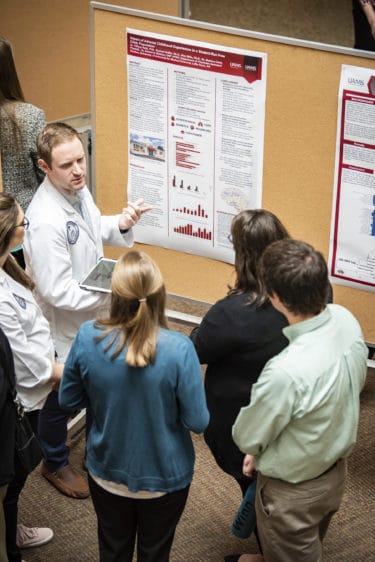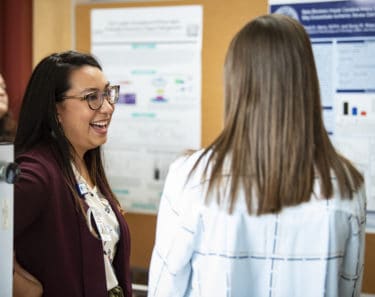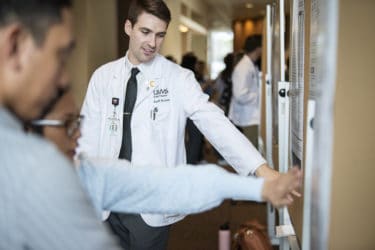Aerospace Medicine Expert: Reach for the Stars by Finding, Believing your Dream
| It’s possible to do things that have never been done before — like sky dive from near space — if you build on the past, learn from your mistakes, and don’t put limits on your dreams, said Jonathan B. Clark, M.D., the distinguished lecturer at Student Research Day.
“Your task is to turn science fiction into science facts,” Clark told the UAMS student body. “And I’m here to tell you, it can be done.”
Clark gave the Robert E. McGehee Jr., Ph.D., Distinguished Lectureship in Biomedical Research on March 10 as part of the UAMS Graduate School’s annual Student Research Day. Throughout the day, about 140 students gave poster and oral presentations.
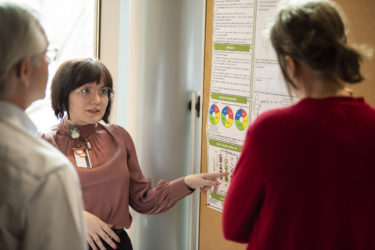
About 140 students from all colleges participated in Student Research Day, giving poster and oral presentations.Bryan Clifton
Clark is an expert in aerospace medicine who has served numerous roles for NASA and the U.S. Navy. He drew on this experience to serve as medical director of the Red Bull Stratos Project, when in 2012 high-altitude diver Felix Baumgartner jumped from the stratosphere at 128,000 feet, traveling in free fall before finishing his decent via parachute. He set the then-record and was the first person to break the sound barrier without being enclosed in a vehicle and using an engine. Clark also worked on Alan Eustace’s 2014 jump from 135,908 feet, the current record.
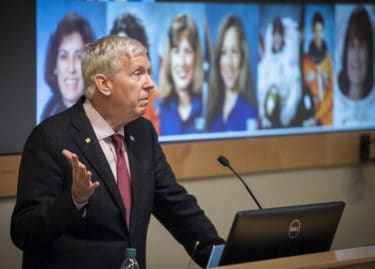
Clark was a six-time space shuttle crew surgeon for NASA and medical director for the Red Bull Stratos Project.Bryan Clifton
As Clark told the students about his career, he spoke of projects that built on each other, how sometimes chance encounters changed his life, and how each challenge he tackled made him better positioned to take on the next. He went into detail on the high-altitude jump projects and some of the medical and engineering “impossibilities” that his team had to solve, like how to keep the jumper’s body from boiling, freezing or vaporizing and how to prevent them from going into a spin with so much force that their blood would have exploded into their extremities.
“Every step of the way we made mistakes, but we didn’t make anybody else’s mistakes,” Clark said, referring to the importance of research in any scientific endeavor. “Our key task was to look at ‘what are the things that can kill you and how are you countering those?’”
How do you accomplish things that have never been done before? Clark had some practical advice:
- Learn from the past — With any idea you have, usually someone has worked on it before and you can build on their work. “You’d be surprised what’s out there,” Clark said.
- Learn from your own mistakes.
- Don’t be afraid to challenge your own assumptions. Embrace the devil’s advocate.
- Come up with a Plan A, Plan B, Plan C, and so on, especially on high-stakes projects.
- If the project involves risk, find ways to test it out in less risky environments.
- If you’re in charge, be the boss you’ve always wanted.
- Find a mentor and be a mentor. Learn from those older and younger than you.
- Find inspiration and pass it on. Find out who you are. Keep a diary and tell your story.
- Make the most of team science — “To me the biggest part of what we do in science and engineering is as a team. This is what as a species allowed us to do the great things that we’ve done. Focus on the team and focus on the issue.
- Never ever give up because your time will come.
Clark worked at NASA from 1997 to 2005 as a six-time space shuttle crew surgeon and chief of the Medical Operations Branch at Johnson Space Center. Clark’s wife, the astronaut Laurel Clark, died along with six fellow crew members in the Space Shuttle Columbia disaster in 2003.
He was a member of the NASA Spacecraft Survival Integrated Investigation Team from 2004 to 2007 that investigated the Columbia disaster and a member of the NASA Constellation Program EVA Systems Project Office Standing Review Board from 2007 to 2010. Before joining NASA, Clark spent 26 years in the U.S. Navy.
Today he is an associate professor of neurology and space medicine at Baylor College of Medicine and teaches operational space medicine at BCM’s Center for Space Medicine. He is also the space medicine adviser for the National Space Biomedical Research Institute. He is a clinical assistant professor in the Department of Preventive Medicine and Community Health at the University of Texas Medical Branch in Galveston and teaches at the UTMB Aerospace Medicine Residency. Clark is a fellow of the Aerospace Medical Association.
Clark received his Bachelor of Science from Texas A&M University and medical degree from the Uniformed Services University of the Health Sciences. He is board certified in neurology and aerospace medicine.Clark thanked Graduate School Dean Robert E. McGehee Jr., Ph.D., for whom the lecture is named, and called it an honor to participate in any educational opportunity.
“Teaching is the central thing. It really is what defines us as human,” Clark said. “Honestly, you guys touch my soul, so go out and fulfill your destiny for all humanity.”
The McGehee Distinguished Lectureship was created in 2011 as an enduring gift from a couple to benefit UAMS and the state by making it possible to invite leading biomedical researchers to share their knowledge and work with students and faculty.
This year, for the first time, McGehee was able to acknowledge the couple publicly by name, Carl D. and Jeannette Purnell of Pine Bluff.“They were incredibly unassuming and really never wanted any recognition for themselves,” McGehee said. “When they made this gift to establish this lecture, they wanted to do so anonymously. They have since passed on and the family came to me and asked if I would remove the anonymity. They gave to many causes on campus, this being just one of them. Thanks to them, we are able to host high-quality speakers in the biomedical field right here at UAMS to teach and inspire for generations to come. I can’t thank them enough.”
Also in a first this year, the oral poster presentation competition called the 3 Minute Thesis was conducted by video link with UAMS Northwest Regional Campus, which had multiple students participate.

